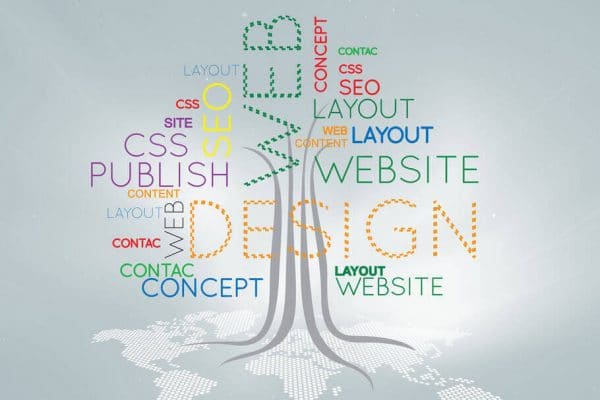The landscape in web development and web design has changed drastically over the past few years. With emerging technologies like Mobile Responsive Web Design and front-end JavaScript application frameworks like Angular and React – coupled with the slow decline of old-faithful tools such as Flash and Fireworks, the line between being a web designer and a web developer has begun to blur together into a single discipline.
Where at one time the role of design was completely separate from the development process, a paradigm shift has begun to emerge which places a strong emphasis on semantic HTML, light-weight CSS, and dynamic JavaScript. In this fashion, the tool set and skills of the modern web designer have evolved from Photoshop, Fireworks and Flash, to more complex hand-crafted coding practices – similar to the back-end web developers who web designers used to hand their designs over to.
Having been in this industry long enough to be well versed in the older technologies as well as the newer more popular methods of modern front-end web development, we understand how excruciatingly confusing and complex the current landscape of front-end web development can seem to new designers. In order to help dispel some of the confusion surrounded by the extremely noisy landscape of web development we would like to give you a few tips to help you keep your eye on the fundamental aspects to web design and web development, without becoming overly concerned with the trendy methodologies.
While these tips may seem very simple and obvious to veteran designers and developers, it’s important to continue the well honed disciplines of those before you. Industry standard best practices have evolved from print media to website design, and following in the footsteps of the pioneers before you can only help in you succeeding as a web designer and web developer.
Start small
Trying to wrap your head around the sheer amount of front-facing web application options in today’s landscape is enough to throw any new designer into a tizzy. Where a designer once knew his domain of expertise like the back of his hand, current advances in broadband speed and device hardware have enabled once static websites to evolve into full-blown dynamic applications. Because of this, it may be hard for a new designer to know exactly where their place is in this new landscape of design and development. Some may feel obligated or pressured into jumping right into higher-level languages and advanced JavaScript frameworks like Angular and React, in order to “keep up with the Joneses”. Some may even chose to adopt the popular moniker: “UI Designer”.
Start small. Understand how to properly mark-up your content with semantic HTML5 without worrying about imbuing them with fancy popup-modals and sliding jQuery carousels. Web design is content design, meaning that at the core of the discipline of web design is the strong focus on defining the content in a webpage so that a browser can read and understand it properly. Web design is not solely about making pretty backgrounds and beautiful text, as design should be used to enhance the visual properties of the content to the user. However, the most important aspect of any website or application is to define the content properly to a web browser and search engine for proper indexing and readability.
So, before you move on to worrying about making everything on your website or application look pretty, focus on how to describe the content in any given section so that your content is accurately and properly marked up for web browsers, search engines, and screen readers.
Design for your users
While we mark-up content for web browsers, search engines and those with visual impairments, when it comes to the design of a web page the room for interpretation can vary widely across users. Sometimes it may be difficult for a designer to let go of their ego and habits, leading them to design a website or application for themselves, instead of for the end-user who will be actively interfacing with your end-product. Without knowing your target market, and the habits of your end-user, you may very well be designing yourself into a hole. One where your preconceived notions of “what is right” blind you from understanding what your end-user feels is “right”.
Just like the old saying “the client is always right” is used as a mantra for many business owners, “the user is always right” should be an ideal you abide by. Gauge user interaction via metrics and by eliciting feedback via polls, newsletters and surveys. Learn what your end-user experiences when they visit your website or use your web application, and don’t be afraid to tweak and modify your work by dispelling preconceived notions that you may or may not stubbornly hold onto. Always remember that you, as the designer, are not the end-user. Even though you may be well versed in the trends and techniques that define your profession, remember that every new product that you develop is going to be interfaced with by users who expect simplicity and familiarity.
Keep it slim
More is not always better. Especially in a realm of technology where your end-user may be accessing your website or application on a wide variety of devices. I am a firm believer that some websites and applications which are bogged down with a plethora of features and dynamic effects end up suffering from what I call “design entropy”. This effect occurs, more times than not, when a designer or developer focuses on cramming their website or application with every cool new technique under the sun. This differs from “scope creep” (a process where combined functionality extends the scope of the development process). Instead, design entropy works against the grain of best practice user experience by saturating your user-interface with features, effects and animations which ultimately work against your application’s end-goal.
When you inundate your end-user with a wide variety of options, not only do they become overloaded by choice, but your design evolves into a Frankenstein like monster where UI elements like navigation, display and interactive elements exceed their allotted space within your website or application. When one design element begins to outweigh the importance and usefulness of other elements in your design, the ability for your end-user to properly interface and interact with your application suffers. Not only do the amount of choices which you present a user within your website work to disconnect them from your application, but the website itself stops achieving its intended goal of supplementing content and user interaction.
Show it off
You will never know if what you’ve built actually achieves its intended goal unless you get it out into the real world and elicit user-feedback. Web designers and web developers often live in the “Bias-Sphere”, a comfortable bubble of self-approval and validation. “Ah, that’s genius! I am a genius! Who would have thought to place x at y?”. While your instincts are more often than not correct, it’s quite easy to design yourself into an iterating loop of confirmation-bias. You will never know if your idea is actually useful or meaningful to end-users unless you reach out to them and listen to their feedback.
Web design, by its very nature, is an extremely personal expression of ones ideas and personality. And since the core of web design is still one of the most important aspects of modern web development, putting yourself out there through creativity is like painting your personality onto the web landscape. And often times this can be a very exposing act, one in which thousands if not millions of people will challenge, dissect, and inspect your ideas through a magnifying glass. So, it’s not hard to see why some web designers and developers choose not to put their creations out there for the world to see before they feel that it’s “done”.
Having their beliefs and the way they see the world challenged by other people can be a very exposing experience for some people. Yet, through the act of being challenged – by having your preconceived world views challenged, you will not only become a better artist – but you will also become a better-rounded designer. One who appreciates user feedback and learns to accept criticism through humility and openness ultimately becomes a more discerning professional. Because, it’s only though the process of allowing your skills, techniques, and personality to be challenged will you be able to transcend from someone who designs blogs and newsletters to someone who has the confidence to design user interfaces which millions of users will make a part of their daily lives.
Keep learning
Complacency is the silent killer of web design and web developer careers. While one should not be expected to keep up with every single new design trend that hits the wire, by not expanding your skill-tree you are only doing yourself and your users an extreme disservice. Learning expands creativity, and through the act of continually pushing yourself and expanding your world view, you will not only receive happiness from creating, but your users will also benefit from higher quality products and user experiences which your personality and love of the work helps embody.
Creativity needs to be fed. Creativity, the act of expressing who you are, should not be limited to what you know, but in terms of web design and development it sometimes is. Because what you know at this moment in time does not have the sustainability of continually feeding your need to express yourself in the ever-evolving landscape of digital media. And when you find yourself reworking the tropes throughout your website or application that you’ve been doing since you first opened a notepad and wrote your first line of code, the feeling of not achieving or fundamentally changing as an artist has the potential to manifest itself.
Because, ultimately, without a continual flow of fresh knowledge to learn from, you may come to the realization that you are not growing as an individual or as an artist. Since almost every web designer or web developer in their career has experienced this – the feeling that you are not growing or expressing yourself in new ways – it’s a good idea to become mindful of when you may be in a rut and push yourself forward through creative momentum.
Never stop challenging yourself to learn new coding languages or new design theories. Carve your own path and challenge the accepted mantras and tropes of today. Harness the full power of a programming language and learn more about yourself through the process. If you only know HTML/CSS at the moment and you feel like you’ve done as much as you can with static pages, then pick up a new language like JavaScript or jQuery. Push yourself to constantly find new ways to bring what you want to say, and how you see the world, onto the web space. By continually challenging yourself not only will your work continue to evolve and enhance in quality, but your joy and fulfillment in your job will help keep you motivated and happy.


